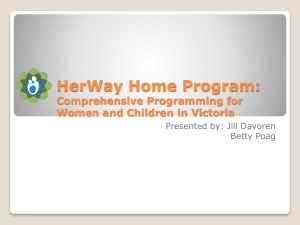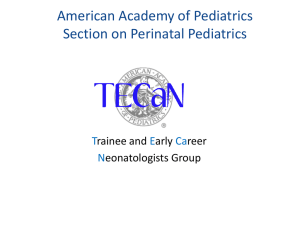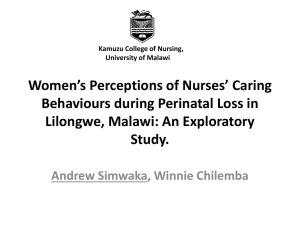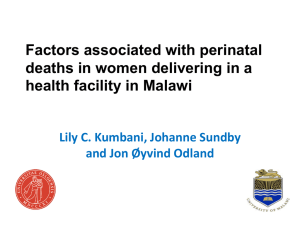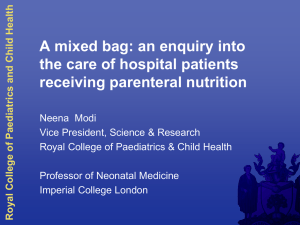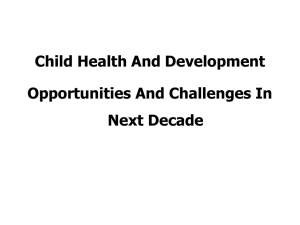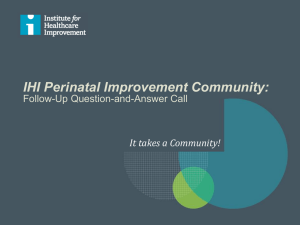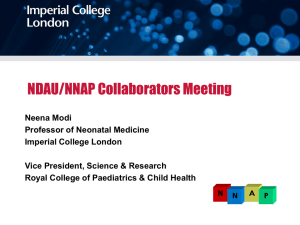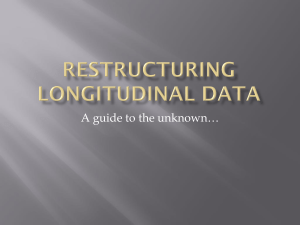1100 Perinatal NZ (2.6 MB, ppt)
advertisement
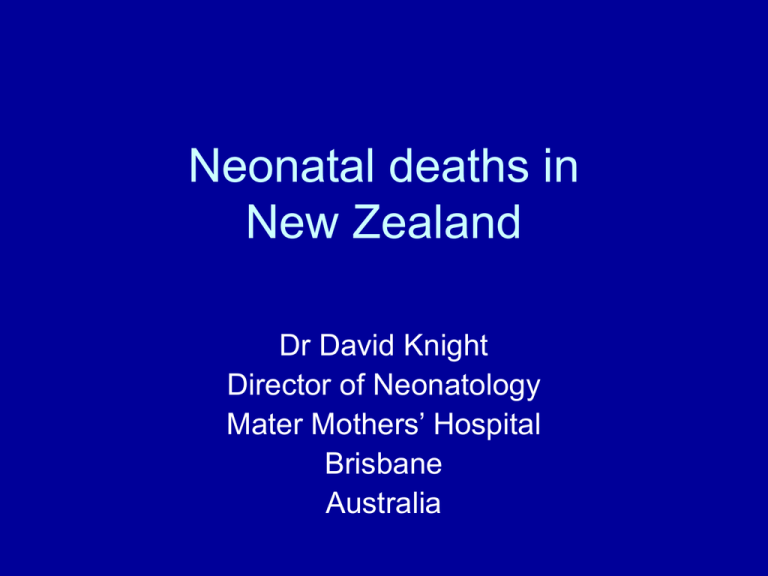
Neonatal deaths in New Zealand Dr David Knight Director of Neonatology Mater Mothers’ Hospital Brisbane Australia Queensland Maternal and Perinatal Quality Council • Chequered history: 3rd iteration • Resurrected 3 years ago • Produces report sent to Minister and Director General of Health • Sub-committees for Perinatal Mortality, Maternal Mortality, Congenital Anomalies and Indigenous Health • Data from QH Perinatal Data Collection – No separate perinatal mortality data source – No mandatory reporting of details of perinatal deaths Perinatal and Maternal Mortality Review Committee • Set up by legislation • Mandatory reporting • Maternal deaths have to be reported to coroner – Almost all have autopsies • Setting up reviews of major maternal and neonatal morbidity Why do babies die (PSANZ)? • PN death classification • – 11 headings – 66 sub-headings • Headings 1. Congenital anomaly 2. Infection 3. Hypertension 4. Antepartum haemorrhage 5. Maternal conditions 6. Perinatal conditions 7. Hypoxic 8. Growth restriction 9. Spontaneous preterm 10. Unexplained 11. No factors Neonatal death classification – 7 headings – 36 sub-headings • Headings 1. 2. 3. 4. 5. 6. 7. Congenital anomaly Extreme prematurity Cardiorespiratory Infection Neurological Gastrointestinal Other Why do babies die (PSANZ)? PN Death classification 1. 2. 3. 4. 5. 6. 7. 8. 9. 10. Congenital anomaly Spontaneous preterm Unexplained Antepartum haemorrhage Perinatal conditions Growth restriction Maternal conditions Hypertension Hypoxic Infection 11. No factors Neonatal death classification 181 108 102 77 75 53 37 28 28 24 7 1. Extreme prematurity 2. Congenital anomaly 3. Neurological 4. Infection 5. Cardiorespiratory 6. Other 7. Gastrointestinal 57 43 40 12 11 11 8 Very preterm babies • PSANZ defines extreme prematurity as – Typically ≤24 weeks or ≤600g and either • Not resuscitated or • Unsuccessful resuscitation or • Unspecified or not known whether resuscitation attempted • Deaths in babies 24-27 weeks (other than “extreme prematurity”) classified as: – – – – – Cardiorespiratory Infection Neurological Gastrointestinal Other Why do live-born babies die? • Congenital anomaly – Lethal/untreatable – Potentially survivable • Extreme preterm <24weeks – Few survivors • Very preterm 24-27 weeks – Potentially survivable • Preterm 28-36 weeks – Should survive • Term and post term – Should survive Scottish Perinatal Mortality Report • Includes tables on “normally-formed birth weight and gestation specific mortality” • Separate for stillbirths and neonatal deaths • Tables are for singletons only Why live-born do babies die? (numbers for 2007-9) • Congenital anomaly 124 25% 155 30% 92 18% 48 9% 106 20% – Lethal/untreatable – Potentially survivable • Extreme preterm ≤24weeks – Few survivors • Very preterm 24-27 weeks – Potentially survivable • Preterm 28-36 weeks – Should survive • Term and post term – Should survive Very preterm 24-27 weeks (numbers for 2007-9) • • • • • • • Cardiorespiratory Extreme preterm Infection Neurological Other Gastrointestinal Total 22 20 18 17 8 7 92 24% 22% 20% 18% 9% 8% Preterm 28-31 weeks (numbers for 2007-9) • • • • • • • Neurological Infection Other Cardiorespiratory Gastrointestinal Extreme preterm Total 21 13 7 3 3 1 48 44% 27% 15% 6% 6% 2% Term and post-term neonatal deaths (numbers for 2007-9) • • • • Neurological Other Infection Cardiorespiratory • Total 64 27 14 1 106 60% 25% 13% 1% How does NZ compare? Neonatal death rate per 1000 live-births Gestation 20-23 NZ UK Australia 2007-9 2007 2008 ? 409 24-27 147 204 28-31 29 34 27 32-36 6 6 4 37-41 0.8 0.9 0.5 42+ 1.2 0.7 1.2 Neonatal death rate NZ 2007-9 excluding deaths from anomalies Live-births* Deaths Rate Rate including anomalies 24-27 643 92 143 147 28-31 1474 20 14 29 32-36 11686 28 2.4 6 37-41 143018 78 0.5 0.8 42+ 36363 28 0.8 1.2 * Live-births less those with lethal anomalies How does NZ compare? Perinatal related death rate per 1000 total births NZ Australia 2007-9 2008 28-31 113 106 32-36 22 19 37-41 3 2 2.8 3.8 Gestation 42+ Perinatal death and multiple birth Births TOP Singleton 61862 2.1 6 2.4 10.5 Multiple 1803 3.3 17.8 18.1 38.8 • • • • Stillbirth Neonatal Perinatal Stillbirth rate 3 greater than that of singletons Neonatal rate 7 greater Perinatal rate 3.7 greater One in 25 perinatal loss Perinatal Mortality of singletons and multiples in Queensland 1995-2007 Queensland Maternal and Perinatal Quality Council. 2010 Birth weight of singletons and multiples Pharoah POD, Clin Perinatol 2006;33:301– 313 Multiple pregnancy rate over time Black M, Bhattacharya S. Seminars in Fetal & Neonatal Medicine 2010;15:306-312 Multiple births and perinatal deaths • Strongly associated with fertility treatment • 7 of 70 perinatal deaths in multiples conceived with IVF, FSH or clomiphene Percentage of multiple births in pregnancies conceived with and without the use of fertility techniques Queensland 1995-2007 Multiple births by maternal age Black M, Bhattacharya S. Seminars in Fetal & Neonatal Medicine 2010;15:306-312 Outlook for multiple pregnancies • • • • • • • Stillbirth rate 3 greater than that of singletons Neonatal death rate 7 greater Perinatal death rate 3.7 greater One in 25 perinatal loss Five time rate of cerebral palsy 1% cerebral palsy Six point reduction in IQ NZ perinatal and maternal mortality report 2009 Pharoah POD, Clin Perinatol 2006;33:301– 313 Cooke RWI, Seminars in Fetal & Neonatal Medicine 2010;15:362-366 Maternal Ethnicity and Neonatal Deaths Births Deaths n % n % rate Māori 14646 23% 68 37% 4.69 Pacific 6823 11% 29 16% 4.30 Indian 2190 3% 11 6% 5.07 Other Asian 4590 7% 9 5% 1.97 Other 5732 9% 8 4% 1.14 NZ European 29684 47% 57 31% 1.94 Maternal Ethnicity and Perinatal Deaths 2008 2009 Neonatal Perinatal Neonatal Perinatal Māori 3.8 10.9 4.7 14.1 Pacific 3.5 13.9 4.3 15.4 Indian 3.6 13.3 5.1 15.1 Other Asian 1.6 8.9 2 9.2 Other 0.9 9.8 1.4 8.7 NZ European 2.4 9.9 1.9 9.5 Socio-economic disadvantage Perinatal related death rates by deprivation quintile Births TOP Stillbirth Neonatal Perinatal 1 10,177 2.5 4.3 1.4 8.2 2 11,225 1.8 4.7 1.8 8.3 3 12,088 2.1 5.5 2.3 9.8 4 13,342 2.3 7.1 3 12.4 5 16,530 2.1 8.1 4.9 15 Perinatal death rate by maternal age <20 20-24 25-29 30-34 35-39 18 Death rate (/1000) 16 14 12 10 8 6 4 2 0 TOP Stillbirth Neonatal death Total perinatal >40 Perinatal death rate by maternal age • Mothers <20 years of age – Increased stillbirth, neonatal and perinatal deaths – Related to smoking (50%) and – SE deprivation (50% in highest quintile) – Ethnicity distribution similar to that of all perinatal deaths • Mothers >40 years of age – Increased TOP, stillbirths and perinatal deaths – Congenital anomalies 5/1000 vs. 3/1000 in younger women “100 babies died needlessly – report” “The deaths of nearly 100 late term and newborn babies could have been prevented in 2009, new figures show.” Contributory factors to perinatal deaths n = 169 • • • • • Organisational Health personnel Technology or equipment Environmental Access/engagement – Acces – Cultural aspects – Social issues – Communication 34 50 6 12 111 Contributory factors to perinatal deaths • Organisational • Health personnel 34 50 – Inadequate education and training – Lack of policies or guidelines – Failure to follow recommended best practice – Knowledge/skill lacking 9 10 24 16 Clinical Guidelines • NZ Guidelines Group: – 1 perinatal guideline, 2004, 106 pages • Professional groups 27 guidelines, succinct, 1-2 pages 65+ guidelines • Individual hospitals 254 neonatal guidelines, short practical guides • Formed in 2009 • Evidence informed consensus guidelines • Produce guidelines – Clinical lead – Volunteer members from interested lay and health groups • Published on the web • Education and audit project • Financial reward to institutions for implementing guidelines • 18 published guidelines – 9 Maternity – 9 Neonatal – 13 to 31 pages long – All have a flow sheet designed for display in clinical units Maternity guidelines • Published – – – – – – – – – Stillbirth care Early onset Group B streptococcal disease Intrapartum fetal surveillance Hypertensive disorders Obesity Vaginal birth after caesarean section Primary post partum haemorrhage Venous thromboembolism prophylaxis Preterm labour • In preparation – – – – – – Non-urgent referral for antenatal care Consultation Maternity shared care Early pregnancy loss Normal birth Perineal care Review: Postpartum haemorrhage Neonatal Guidelines • Published – – – – – – – – – Breastfeeding initiation Examination of the newborn Neonatal hypoglycaemia Hypoxic ischaemic encephalopathy Neonatal jaundice Neonatal abstinence syndrome Respiratory distress and CPAP Neonatal resuscitation Term small for gestational age baby • In preparation – – – – Neonatal stabilisation for retrieval Neonatal pain Neonatal seizures Review – neonatal resuscitation Controlled trials: is this the first? Holy Roman Emperor Frederick II 1194-1250 • Aim: – Does exercise influence digestion? • Designed a controlled clinical trial • 2 Knights ate a meal – 1 exercised – 1 slept • Killed both Knights and looked at stomach contents • Conclusion: – Exercise inhibits gastric emptying Controlled trials • Bill Silverman and retinopathy of prematurity • Mont Liggins, Ross Howie and antenatal steroids • Brian Darlow and the Boost II studies – Oxygen saturation targeting in preterm infants Epidemiology: Florence Nightingale • Educated woman – Latin, Greek, History, Mathematics • Used statistics to prove her hypotheses • 1st female member of Royal Statistical Society in 1858 • Honorary member of American Statistical Society Epidemiology • Richard Doll, Austin Bradford and smoking • NZ Perinatal and Maternal Mortality Review Committee Conclusions • NZ has an impressive setup for gathering data • The report in comprehensive and timely • The report contains detailed analysis of deaths, not just raw data • Needs more data on all births so that denominator known in subgroups Suggestion • Separate reporting of congenital anomalies • Data on gestational age and birth weight specific mortality in babies without anomalies Conclusion • NZ outcomes compare well with UK and Australia • Outcomes for multiple pregnancies significantly worse than for singletons • Worse outcome for youngest and oldest mothers • Noteworthy that there is an uneven risk related to ethnicity, deprivation decile and DHB of birth – DHB outcomes likely to related to the other two factors – This is seen in all countries Thank you for the invitation to comment on this impressive report and these excellent results
